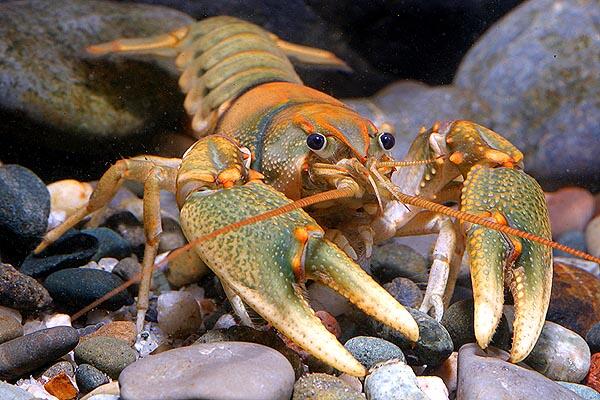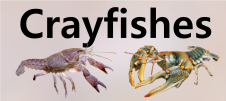







Loading profile. Please wait . . .
Cambarus coosae Hobbs, 1981
Coosa Crayfish




Federal Protection: No US federal protection
State Protection: No Georgia state protection
Global Rank: G5
State Rank: S4S5
Element Locations Tracked in Biotics: No
SWAP 2015 Species of Greatest Conservation Need (SGCN): No
SWAP 2025 Species of Greatest Conservation Need (SGCN): No
2025 SGCN Priority Tier: None
Element Occurrences (EOs) in Georgia: 0
Habitat Summary for element in Georgia: Associated with rocks in flowing areas of small streams to medium-sized rivers
The Coosa Crayfish displays a variety of color patterns across its range. The overall base colors may consist of tans, browns, olives, greens, and blues. The carapace is typically tan or greenish-bluish with darker brown bands anterior to, and posterior to the areola, creating a saddled appearance. The cervical spines, all tubercles, and margins of the rostrum are bright red or reddish orange, and the rear edge of each abdominal segment is deep red or burgundy. The areola is wide and there is a single strong cervical spine. The rostrum is fairly long and slightly to obviously “pinched”, with marginal spines or tubercles. The fingers of the claws may touch throughout their length (Conasauga River) or have a gap between the fingers (Coosawattee tribs and south). This species reaches a maximum total body length of about 80 mm (3.1 in).
The only other species that occurs with the Coosa Crayfish that possesses a single sharp cervical spine is the Coosa River Spiny Crayfish, Orconectes spinosus. However, the cervical spine of O. spinosus is not red and there are obvious black spots on the claw of this species where the movable finger connects; this area on the Coosa Crayfish is bright red.
The Coosa Crayfish is a stream dweller and can be found in small spring runs less than 1-m wide to the mainstem of medium-sized rivers like the Conasauga. This species is typically found beneath rocks.
No studies of the Coosa Crayfish are known. Crayfishes are considered opportunistic omnivores and likely feed on live and decaying vegetation, aquatic insect larvae, small fishes, and dead animal matter.
Stream dwelling crayfishes typically hide during the day and come out at night to feed. Reproduction usually occurs during the spring and fall, but males in reproductive condition may be found at any time during the year. When female crayfish are ready to lay eggs, they usually find a secure hiding place and hence are rarely encountered. When the eggs are released, the female attaches them to her swimmerets and is said to be "in berry." Upon hatching, the juvenile crayfish are attached to the mother by a thread. After the juveniles molt for the second time, they are free of the mother, but stay close and will hold on to her for some time. Eventually they move off on their own. Crayfishes molt 6 or 7 times during their first year of life and most are probably able to reproduce by the end of that year. They molt once or twice a year for the remainder of their lives and live about 3 years. Male Coosa Crayfish in reproductive condition have been collected in all months except December, January, and February, although first form males are more common in the fall and spring. The lack of breeding males in the winter months is likely an artifact of the small number of collections made during that period. Ten females carrying eggs were found in April and one in July. Numbers of eggs per female ranged from 74 to 167. The smallest breeding male known is about 50 mm (2.0 in) and the smallest female carrying eggs is about 50-mm (2 in) in length (Hobbs 1981).
Since this species is usually found in flowing water, it is most easily collected by holding a net perpendicular to the current downstream of a large rock, then lifting the rock and disturbing the substrate beneath it. If a crayfish is hiding underneath the rock, it will likely move into the net. Shocking downstream into a seine net with a backpack electroshocker is also effective as well as setting baited minnow traps overnight.
The Coosa Crayfish is endemic to the Coosa River basin in Alabama, Georgia, and Tennessee. The majority of its range is in Georgia where it inhabits the Conasauga, Coosa, and Oostanaula river systems as well as the lower portions of the Coosawattee and Etowah river systems.
Heavy sedimentation resulting from poor development and land management practices may cover substrates and other daytime hiding places on which crayfishes rely to avoid predation. The introduction of non-native crayfishes is a threat to all native crayfishes.
This species is widespread and common and apparently stable in Georgia.
Conserving populations of the Coosa Crayfish will require general watershed level protection measures, including the protection of riparian zones, control of sediment and nutrient runoff from farms and construction sites, and limiting the amount of impervious cover (e.g., pavement) within occupied watersheds. Non-native crayfishes should never be used for bait; instead, anglers should use crayfishes collected from the river system where they will be fishing. Unused bait of any kind should not be released back into Georgia waters.
Hobbs, H.H., Jr. 1981. The crayfishes of Georgia. Smithsonian Contributions to Zoology 318:1–549.
Taylor, C.A., G.A. Schuster, J.E. Cooper, R.J. DiStefano, A.G. Eversole, P. Hamr, H.H. Hobbs III, H.W. Robison, C.E. Skelton, and R.F. Thoma. 2007. A reassessment of the conservation status of crayfishes of the United States and Canada after 10+ years of increased awareness. Fisheries 32:372–389.
Christopher E. Skelton
C. Skelton, 2012: original account
C. Skelton, February 2019: general update of account.
DW, August 2019: photos added.
C. Skelton, February 2021: added C. Williams photo